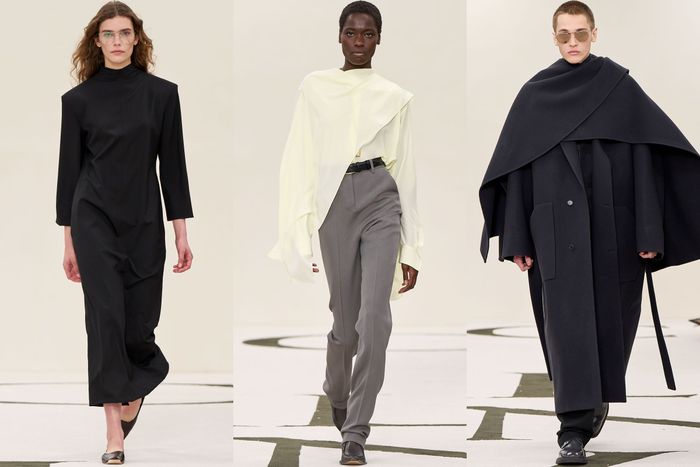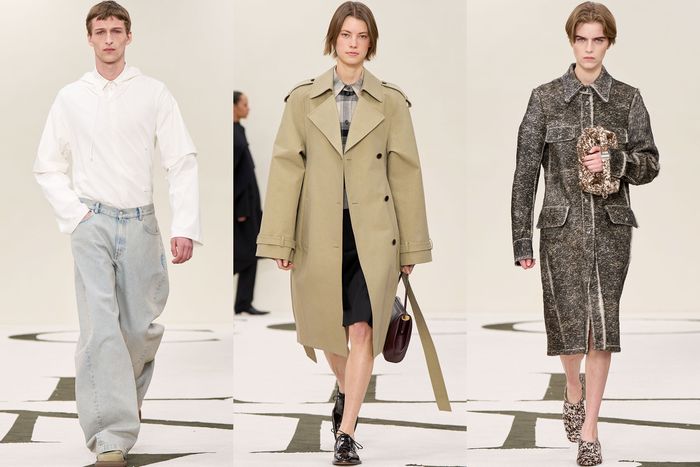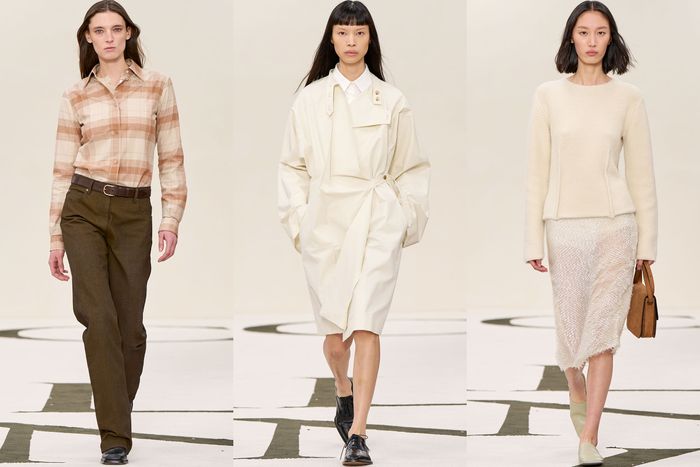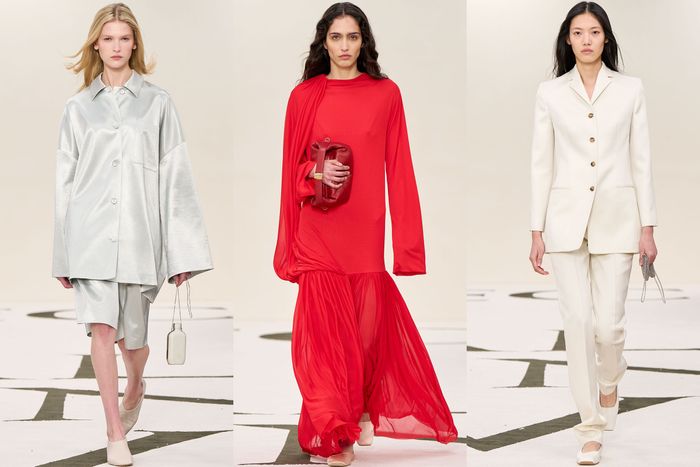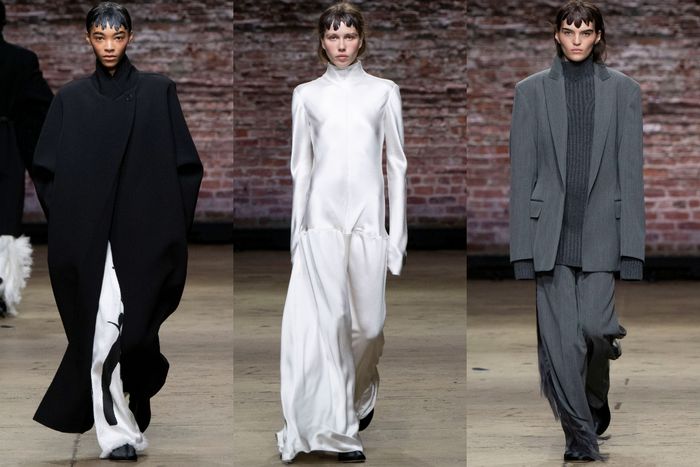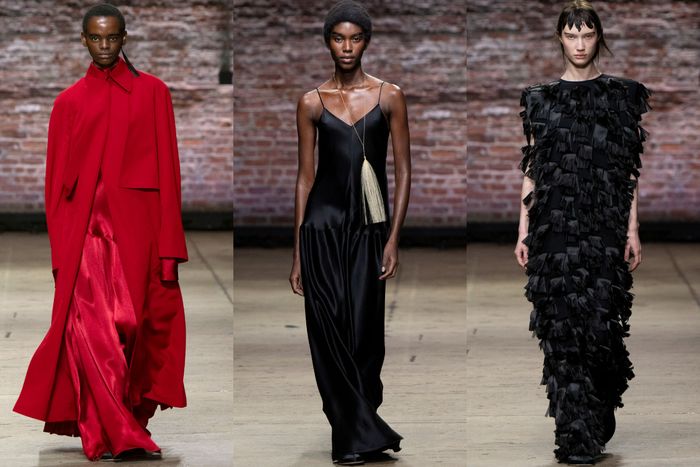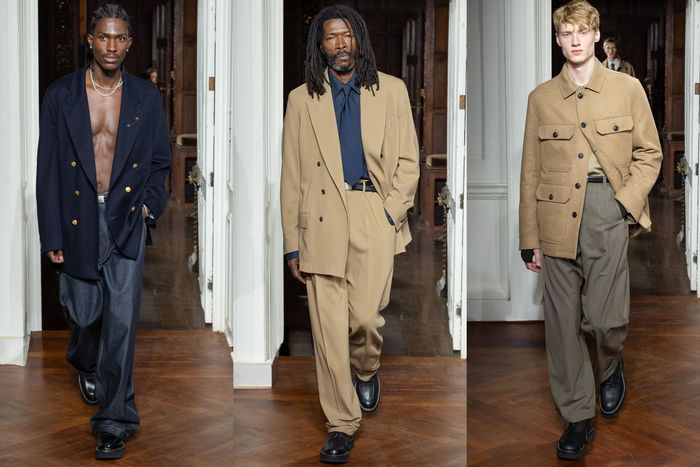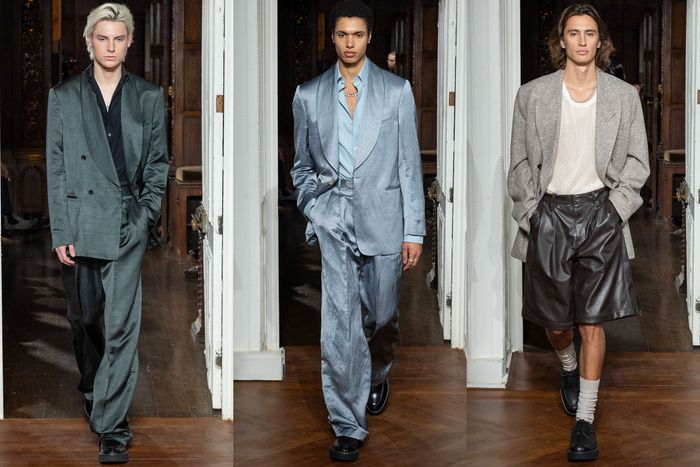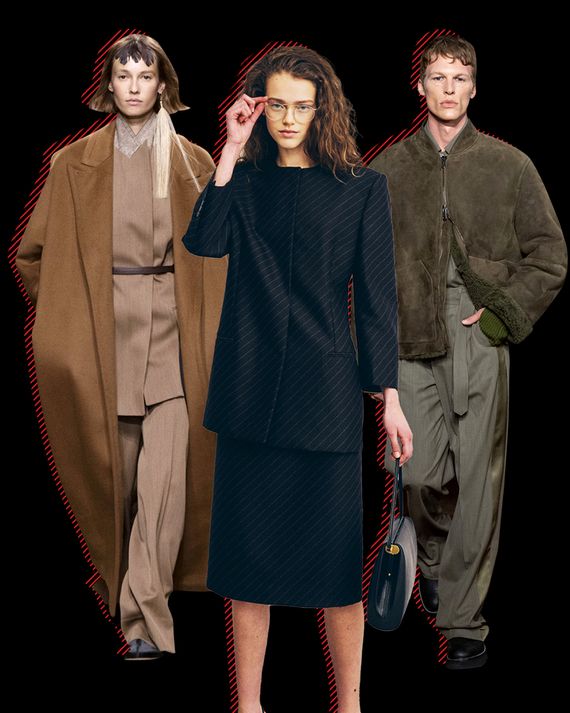
In the fall of 2018, when Raf Simons did his “Jaws” collection for Calvin Klein — remember the shark tank top? — I found myself getting restless to see his take on minimalism, and I told him so after the show. After all, Simons is a master of minimalism. He knows his way around the form as well as any of its practitioners, and he knows their work, too, whether it’s Helmut Lang or Jil Sander. But it was not to be. Simons got the boot from Calvin Klein and its parent company, PVH, later that year. Eventually, he got a call from Patrizio Bertelli and joined Prada.
A European with a fascination with American culture, Simons may have worn thin the horror movie themes and the Warhol imagery, but a lot of people will remember something from his debut show. Julia Nobis in a yellow shag fur coat covered in clear vinyl like your granny’s Davenport. The boys and girls in the western wear. The sexy fit of a tweed pantsuit and no shirt underneath. The artist Sterling Ruby’s pompoms and flags hanging from the ceiling of the West 39th Street show space. I got up from that show, as many did, feeling excited and hopeful.
On Friday, in the same space, I felt almost nothing at the conclusion of Veronica Leoni’s show — the first collection line from the brand in seven years. To me, the vibe in the vast, columned room was part corporate, with cream wall-to-wall carpet stamped with what looked like a Calvin Klein logo, and part a weirdly hollow nostalgia trip, with Calvin Klein himself, at 82, in the front row next to his former wife, Kelly Klein.
The designer, who founded the sportswear company in 1968 with Barry K. Schwartz, a childhood friend from the Bronx, hasn’t been a presence at the shows for ages. (He and Schwartz sold the brand to PVH in 2003.) So what did it mean on Friday? It’s nice to be respectful to a founder and a legend, one whose taste influenced style and advertising in the 1980s and 90s. However, in my view, Leoni and the Calvin Klein company needed to make a clean break again, as Simons did in 2017. Leave the past in the past. And instead, give us a strong sense of change.
So that was Leoni’s first error of judgment. The second was that the clothes and the aesthetic (also reflected in her choice of models) were not distinctive enough. Earlier this week, on Wednesday, I met Leoni in the company’s offices and she felt there was space in the market for another minimalist label, in part because some others lacked sophistication, as she put it. “The big mistake is to think that minimalism means commercial,” said Leoni, who lives in Rome and has worked for Celine, Jil Sander and The Row.
Actually, I doubt that any sophisticated fashion consumer thinks that. We’ve seen so many great iterations of minimalism in the last decade — in most seasons from the Olsen sisters; from Co, a label that originated in Los Angeles; from Fforme and Maria McManus, both in New York City, and Phoebe Philo since she launched her label. We also have the legacy of a designer like Lang. It was so powerful and original that no successor, certainly not Peter Do, has been able to capture it adequately.
How do you decode Calvin’s minimalism? That’s easy. It’s sexy and cool. You could even throw in a little grunge from the Kate Moss-Mario Sorrenti era — that is, unless today’s corporate culture is too wholesome for it. But, anyway, that’s what Leoni’s collection needed — a lot more sex appeal. It was generally too buttoned up, without languor. Oddly, when I visited her, she showed me an ivory slip made in a technical viscose — meaning it felt crisp. It was a lovely thing, cool. But if Leoni put the slip in the show, it must have been buried under something because I didn’t see it.
Her strong points in the collection were overcoats and trenches, and some of the suiting, notably a trim style in charcoal pinstripes set on the bias. Her ballet flats and low-heels (drawn from the archive) were a nice touch. Once people can try on the clothes and touch some of the better fabrics, like the poplin shirting and the outerwear materials, they may see a difference, but on the runway that distinctiveness wasn’t evident. Leoni may have been opting for that standard palette-cleansing opener, which is purist and rather strict. But, given the competition, that just puts you at the commercial level. And what this new collection needed at the outset was a striking difference.
The other anticipated debut on Friday was at Fforme, where Frances Howie takes over from veteran Paul Helbers, who helped launch the label in 2022. Howie, a New Zealand native and a graduate of Central Saint Martins in London, spent about three years working for the late Alber Elbaz at Lanvin — during his influential years — and a dozen years as a designer at Stella McCartney.
“What I’m obsessed with is making this modern femininity,” said Howie a few days before her show. “What is after minimalism? Where do we go? As a woman, I still desire these tactile things. But I also want strength.” And, she added pointedly, “And not just looking dressed up.”
Although Howie, in her presentation, made the same error as Leoni of keeping things overly buttoned up, she strikes a finer balance between masculine and feminine, between an expertly tailored, mildly oversized jacket in an Italian wool-melange twill and the sensuality of a long slip dress in (a very tactile) hammered viscose. That dress got lost on the runway, but it’s a beauty. The upper part was cut on the bias and the lower on the straight grain, and the tension of the two cuts created a natural ripple effect where they meet at the hips. (Howie also did a long-sleeve, mock-neck version in deep red.)
Another thing you couldn’t see on the runway was that an opening trench coat could be converted into a sleeveless dress; you just remove the coat flap. The back was finished with a narrow row of pleats.
I like the way Howie thinks. Indeed, one of the things she clearly learned from Elbaz was how to solve problems, and with a minimum of bother. She proposed a sack dress for the evening adorned with folded pieces of satin ribbon left to fray, and she turned the selvage ends of a crinkly silk/viscose fabric into simple trim detail for a plain top or a tube skirt.
As we looked at a long black coat in a viscose twill, Howie said, “I’m thinking we might do a matching two-piece look under it.” That thought, I said, is very Zoranian — meaning Zoran, who left his imprint on minimalism with clothes in four or five colors and fabrics that used no buttons or zippers, and whose work has been copied and copied.
But Howie knew what I meant, really. You want the feeling of an underpinning and, at the same, the feeling of nothing. That’s freedom and power rolled into one anonymous-looking minimalist package. Philo gets that. Apparently, Frances Howie does, too.
Todd Snyder, the only dedicated men’s designer showing this week in New York, located his collection in Saint-Germain, the Left Bank Paris neighborhood, the historical home of writers, fashion designers and lately fans of “Emily in Paris.”
Snyder, who has about twenty stores of his own and would like to open one in Europe, ideally London, said, “A lot of my inspiration comes from vintage. Music. Art. I always think, What’s the car? What’s the watch he’s wearing? It creates a vibe.”
And how. Snyder gave the merest sartorial, jazzy hint of that famed Parisian quarter while avoiding the hideous cliches. There was a dose of French workwear in sharp, patch-pocket jackets worn with soft trousers that hit a little higher (just right) on the waist and nod to bored but dreamy school boys with baggy shorts in leather with blazers or overcoats. Snyder’s cuts were a bit more oversized this season, in tune with things.
For me, though, the most satisfying part of watching this briskly cool show—at an uptown mansion—was the bounty of color (bottle green to moss; sky blue to petrol and navy) and fabrics, including wools, alpaca, corduroy, velvet and brushed satin (for terrific, romantic looking evening suits). By contrast, many of the women’s collections seemed starved for choice or so overtly feminine, with poufs and lacing, they seem poisonous.



